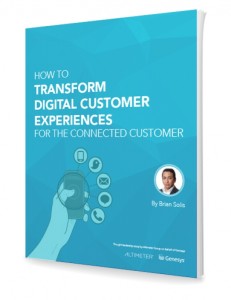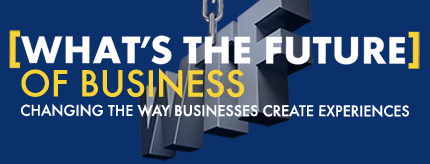All customers are not created equal. This is also true for relationships. No business has the same relationship with their customers as you intend to have with yours. The thing is though, you must first define what a relationship with your customer looks and feels like and in turn, how they would describe it to their friends and colleagues. This is where the future of customer experience begins.
At a time when technology is affecting how people go through life, one thing is becoming clear, everything is changing and that also affects the business of business. At the same time, technology is introducing new opportunities to improve customer relationships and ultimately the experiences we want them to have and share. In fact, I’d say that as crazy as all this new stuff is (social media, mobile apps, smart watches, smart phones, smart cars, smart appliances, wearable computers, virtual reality, etc.), companies now have the opportunity to become more human and more relevant than ever before.
Every one of these new technologies provides us with greater insights into customer behaviors and aspirations. We can better know our customers, appreciate their expectations and in turn, deliver more personal and valuable customer experiences. The challenge is that we have to want to and we need to do things differently in order to do so.
The good news is that consumer technology isn’t the only sector undergoing great innovation and disruption. Innovation is also underway in the world of enterprise software. Now well-intended businesses have the technology that facilitates improved customer relationships and experiences. Again, businesses will have want to make investments in innovation to do so.
Transform Digital Customer Experience for the Connected Customer
I recently partnered with Genesys to explore the state and future of customer experience (CX). Through research, we aligned evolving customer expectations with the best practices of those companies that get it (see the video below). The result is a new thought leadership study available today, How to Transform Digital Customer Experiences for the Connected Customer. You can get it here!
How you invest in your CX is the difference between a compelling competitive advantage and mediocrity and irrelevance.
It’s a bold leap forward to trust something as fickle as a customer relationship. But what if it wasn’t so fickle? What if the customer relationship were inherently trustworthy because of the effort you invested in its promise?
That’s the importance of CX. Customer relationships are a byproduct of the experience you design, support and reinforce.
Everything starts with a vision for what the customer experience could be compared to what it is today. Naturally, you’ll find a gap. Closing this gap immediately is your CX imperative. Investing in the CX to bring your vision to life is your competitive advantage.
CX matters.
Every touch matters.
It just takes a common vision to take everything to an entirely different level.
I hope this thought leadership study will serve as your guide to digital transformation and more so, consumer relevance and improved customer experiences and relationships.
Connect with me… Twitter | LinkedIn | Facebook | Youtube | Instagram | Pinterest
Image Credit: Shutterstock








I work at a start up in AZ managing the customer experience. I have to say, I’m extremely pleased to see you and your partners taking such an interest in customer experience. I think that as we’re all attempting to come up with the next best product or service (or startup), we tend to forget that brand loyalty is created not just through marketing, but even more specifically real shared experiences.
Marketing is a strategic/tactical way that businesses attempt to create these shared experiences when people aren’t looking for them. Or an attempt to catch someones attention when they’re searching for something but don’t quite know the right solution to their own problem yet. That’s all well and good, you probably already knew that, but at the end of the day, everything comes back to customer experience. The overall experience with your business, not just one cool feature of your flagship product. It doesn’t matter if you have the best dev’s in the world, if your customer service sucks, people will not stick with your brand in 2015. (You can’t just keep deleting people’s angry Facebook comments!)
Business is still human, it always has been, and always will be.
The reason I’ve been talking about marketing in this comment is because I feel like the role of customer experience is comparable to the role of a UX/UI person on the product side, giving marketer’s their first real chance to dabble in the creation of “user experience” (which is a “cool” profession to have these days) without having to know how to code. And the good news is that the people who are truly passionate about their business and truly care about the people they are attempting to serve will jump at this chance to be held accountable for the customer experience.
Because that’s what this really is right? The next step in corporate accountability. Planning for success also means sometimes taking responsibility for your failures when things don’t work out. More accountability scares people who are already scared about hitting sales numbers and appeasing investors (all understandably). But if you put customer experience at the front of your brand and core values, the rest will really take care of itself (like we’ve seen with Zappos).
It only takes one look at Brian’s Dynamic consumer journey diagram (https://www.briansolis.com/2013/04/the-dim-light-at-the-end-of-the-funnel/) to understand that you have to excel at each step of the consumers journey, both online and off. Especially if you don’t have the best product in your vertical.
There are a few ways to win. 1) Have the lowest price (Walmart) 2) Best logistics (Amazon) or 3) Best overall experience.
There can only be one winner in the former 2 categories, but the 3rd, well that’s open to your customers interpretation…and their interpretation…well…that opinion will be formed by their customer experience.
Thank you for such a thought comment. It’s like a post within a post! Love the comparison between UX and CX. It’s the foundation for my next book!
haha, post-ception! Looking forward to the next book Brian, thanks for continuing to drop knowledge!
Very interesting article
and video as always, Brian. I completely agree, technology is not only
changing the way we work and our personal lives, it’s changing the way
customers are interacting with brands. Today, there is more competition
and more demand for good service from customers and it’s important for
companies to find ways to impress new customers – and retain old customers – right
from the first interaction. Customers continuously judge companies based
on their experience and can easily turn from loyal to brand basher
based on one bad experience. First, brands need to make sure they
understand their customer base and their preferred communication
preference. From there, it’s imperative that the company is accessible on
every relevant platform, whether it is social media, online chat or the
traditional phone. The next step is ensuring the right technology is in
place to make customer interactions simple and informative. During any
customer interaction, especially the first, they are sharing a wealth of
important data including their name, contact information and even
information on their interests, lifestyles and preferences. In today’s
era of disruptive technologies, it is imperative for businesses to
capture this and use it to acquire valuable insights that enhance the
customer experience. Simply speaking, if we want to build and maintain
loyal, satisfied customers and other constituents we serve, we have to
reduce their effort and make it easy for them to do business with us.
While it may seem like a scary task, there is a ton of technology that
companies can implement to help automate and amplify the process. – Andy Jones, Xerox, @AndyJonesXerox
Well said. Thank you. Everything should be invisible… #frictionless